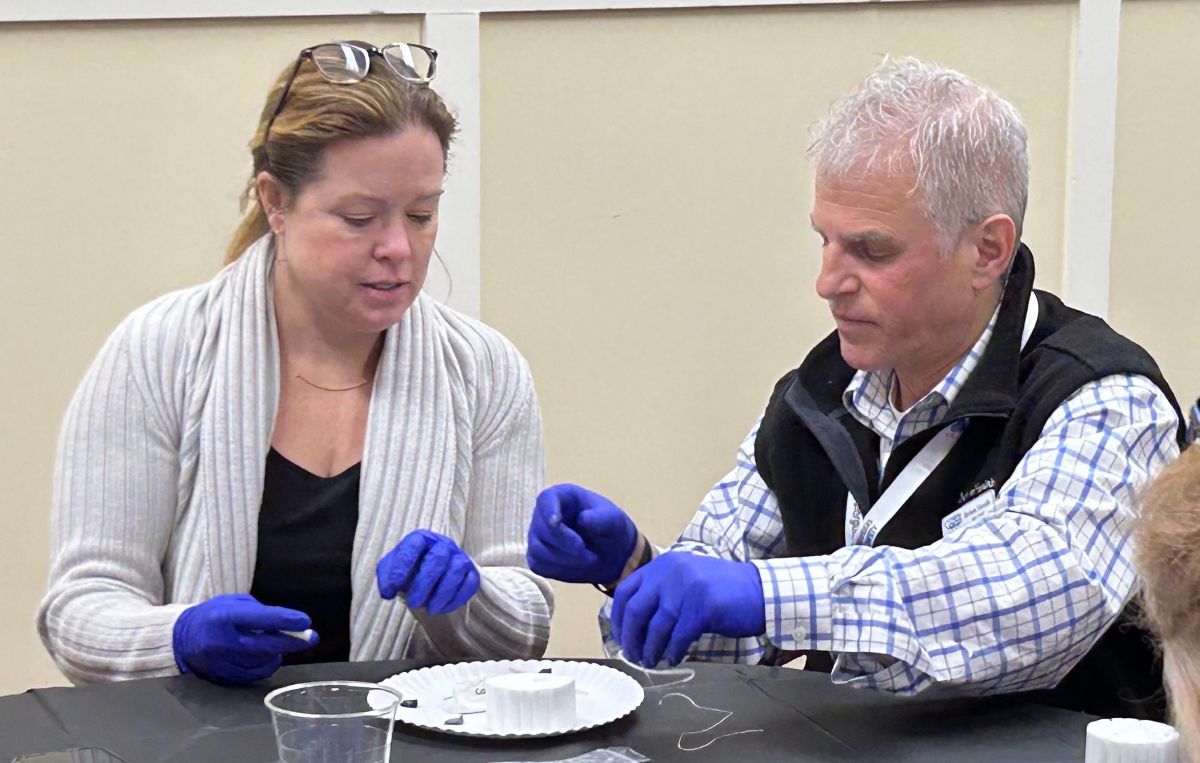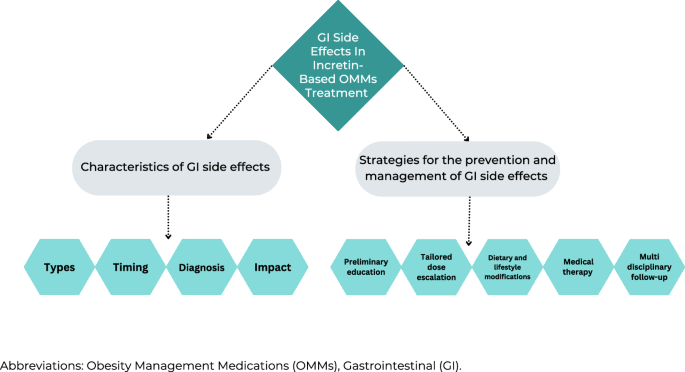Wharton S, Lau DCW, Vallis M, Sharma AM, Biertho L, Campbell-Scherer D, et al. Obesity in adults: a clinical practice guideline. CMAJ. 2020;192:E875–91.
Google Scholar
Busetto L, Dicker D, Frühbeck G, Halford JCG, Sbraccia P, Yumuk V, et al. A new framework for the diagnosis, staging and management of obesity in adults. Nat Med. 2024;30:2395–99.
Google Scholar
Lobstein T, Jackson-Leach R, Powis J, Brinsden H, Gray M. World obesity atlas 2023. World Obes Fed. 2023:5–25. www.johnclarksondesign.co.uk.
Wilding JPH, Batterham RL, Calanna S, Davies M, Van Gaal LF, Lingvay I, et al. Once-weekly semaglutide in adults with overweight or obesity. N Engl J Med. 2021;384:989–1002.
Google Scholar
Pi-Sunyer X, Astrup A, Fujioka K, Greenway F, Halpern A, Krempf M, et al. A randomized, controlled trial of 3.0 mg of liraglutide in weight management. N Engl J Med. 2015;373:11–22.
Google Scholar
Jastreboff AM, Aronne LJ, Ahmad NN, Wharton S, Connery L, Alves B, et al. Tirzepatide once weekly for the treatment of obesity. N Engl J Med. 2022;387:205–16.
Google Scholar
Müllertz ALO, Sandsdal RM, Jensen SBK, Torekov SS. Potent incretin-based therapy for obesity: a systematic review and meta-analysis of the efficacy of semaglutide and tirzepatide on body weight and waist circumference, and safety. Obes Rev. 2024;25:1–19.
Davies M, Færch L, Jeppesen OK, Pakseresht A, Pedersen SD, Perreault L, et al. Semaglutide 2·4 mg once a week in adults with overweight or obesity, and type 2 diabetes (STEP 2): a randomised, double-blind, double-dummy, placebo-controlled, phase 3 trial. Lancet. 2021;397:971–84.
Google Scholar
Wadden TA, Bailey TS, Billings LK, Davies M, Frias JP, Koroleva A, et al. Effect of subcutaneous semaglutide vs placebo as an adjunct to intensive behavioral therapy on body weight in adults with overweight or obesity: the STEP 3 randomized clinical trial. J Am Med Assoc. 2021;325:1403–13.
Google Scholar
Garvey WT, Batterham RL, Bhatta M, Buscemi S, Christensen LN, Frias JP, et al. Two-year effects of semaglutide in adults with overweight or obesity: the STEP 5 trial. Nat Med. 2022;28:2–5.
Rubino DM, Greenway FL, Khalid U, O’Neil PM, Rosenstock J, Sørrig R, et al. Effect of weekly subcutaneous semaglutide vs daily liraglutide on body weight in adults with overweight or obesity without diabetes: the STEP 8 randomized clinical trial. JAMA. 2022;327:138–50.
Google Scholar
Blackman A, Foster GD, Zammit G, Rosenberg R, Aronne L, Wadden T, et al. Effect of liraglutide 3.0 mg in individuals with obesity and moderate or severe obstructive sleep apnea: the scale sleep apnea randomized clinical trial. Int J Obes. 2016;40:1310–9.
Google Scholar
Wadden TA, Hollander P, Klein S, Niswender K, Woo V, Hale PM, et al. Weight maintenance and additional weight loss with liraglutide after low-calorie-diet-induced weight loss: the SCALE Maintenance randomized study. Int J Obes. 2013;37:1443–51.
Google Scholar
Ghusn W, De La Rosa A, Sacoto D, Cifuentes L, Campos A, Feris F, et al. Weight loss outcomes associated with semaglutide treatment for patients with overweight or obesity. JAMA Netw Open. 2022;5:E2231982.
Google Scholar
Aldhaleei WA, Abegaz TM, Bhagavathula AS. Glucagon-like peptide-1 receptor agonists associated gastrointestinal adverse events: a cross-sectional analysis of the National Institutes of Health All of Us Cohort. Pharmaceuticals. 2024;17:199.
Google Scholar
Tzoulis P, Batavanis M, Baldeweg S. A real-world study of the effectiveness and safety of semaglutide for weight loss. Cureus. 2024;16:1–12.
Cabral Lopes A, Roque F, Lourenço O, Herdeiro MT, Morgado M. Gastrointestinal disorders potentially associated with Semaglutide: an analysis from the Eudravigilance Database. Expert Opin Drug Saf. 2023;22:455–61. https://doi.org/10.1080/14740338.2023.2172159.
Google Scholar
Wharton S, Calanna S, Davies M, Dicker D, Goldman B, Lingvay I, et al. Gastrointestinal tolerability of once-weekly semaglutide 2.4 mg in adults with overweight or obesity, and the relationship between gastrointestinal adverse events and weight loss. Diab Obes Metab. 2022;24:94–105.
Google Scholar
Kanoski SE, Hayes MR, Skibicka KP. GLP-1 and weight loss: unraveling the diverse neural circuitry. Am J Physiol Regul Integr Comp Physiol. 2016;310:R885–95.
Google Scholar
Horowitz M, Aroda VR, Han J, Hardy E, Rayner CK. Upper and/or lower gastrointestinal adverse events with glucagon-like peptide-1 receptor agonists: Incidence and consequences. Diab Obes Metab. 2017;19:672–81.
Google Scholar
Wharton S, Davies M, Dicker D, Lingvay I, Mosenzon O, Rubino DM, et al. Managing the gastrointestinal side effects of GLP-1 receptor agonists in obesity: recommendations for clinical practice. Postgrad Med. 2022;134:14–9. https://doi.org/10.1080/00325481.2021.2002616.
Google Scholar
O’Neil PM, Birkenfeld AL, McGowan B, Mosenzon O, Pedersen SD, Wharton S, et al. Efficacy and safety of semaglutide compared with liraglutide and placebo for weight loss in patients with obesity: a randomised, double-blind, placebo and active controlled, dose-ranging, phase 2 trial. Lancet. 2018;392:637–49. https://doi.org/10.1016/S0140-6736(18)31773-2.
Google Scholar
Martin AA, Wood R, Leith A, Piercy J, Higgins V. Reasons for discontinuation of GLP1 receptor agonists: data from a real-world cross-sectional survey of physicians and their patients with type 2 diabetes. Diabetes Metab Syndr Obes. 2017;10:403–12.
Lee J, Kim R, Kim MH, Lee SH, Cho JH, Lee JM, et al. Weight loss and side-effects of liraglutide and lixisenatide in obesity and type 2 diabetes mellitus. Prim Care Diab. 2023;17:460–5. https://doi.org/10.1016/j.pcd.2023.07.006.
Google Scholar
Trujillo JM, Nuffer W, Smith BA. GLP-1 receptor agonists: an updated review of head-to-head clinical studies. Ther Adv Endocrinol Metab. 2021;12:1–15.
Gorgojo-Martínez JJ, Mezquita-Raya P, Carretero-Gómez J, Castro A, Cebrián-Cuenca A, de Torres-Sánchez A, et al. Clinical recommendations to manage gastrointestinal adverse events in patients treated with Glp-1 receptor agonists: a multidisciplinary expert consensus. J Clin Med. 2022;12:145.
Wadden TA, Chao AM, Moore M, Tronieri JS, Gilden A, Amaro A, et al. The role of lifestyle modification with second-generation anti-obesity medications: comparisons, questions, and clinical opportunities. Curr Obes Rep. 2023;12:453–73.
Google Scholar
Almandoz JP, Wadden TA, Tewksbury C, Apovian CM, Fitch A, Ard JD, et al. Nutritional considerations with antiobesity medications. Obesity. 2024;32:1613–31.
Google Scholar
Miller T, Reihlen M. Assessing the impact of patient-involvement healthcare strategies on patients, providers, and the healthcare system: a systematic review. Patient Educ Couns. 2023;110:107652. https://doi.org/10.1016/j.pec.2023.107652.
Google Scholar
Bradshaw C, Atkinson S, Doody O. Employing a qualitative description approach in health care research. Glob Qual Nurs Res. 2017;4:2333393617742282.
Caelli K, Ray L, Mill J. Clear as mud’: toward greater clarity in generic qualitative research. Int J Qual Methods. 2003;2:1–13.
Tong A, Sainsbury P, Craig J. Consolidated criteria for reporting qualitative research (COREQ): a 32-item checklist for interviews and focus groups. Int J Qual Heal Care. 2007;19:349–57.
Kallio H, Pietilä AM, Johnson M, Kangasniemi M. Systematic methodological review: developing a framework for a qualitative semi-structured interview guide. J Adv Nurs. 2016;72:2954–65.
Google Scholar
Polit DF, Beck CT. Sampling in quantitative research. In: Nursing research: generating and assessing evidence for nursing practice. 10th ed. Lippincott Williams & Wilkins; 2018. pp. 365–88.
Hsieh HF, Shannon SE. Three approaches to qualitative content analysis. Qual Health Res. 2005;15:1277–88.
Google Scholar
Fereday J, Muir-Cochrane E. Demonstrating rigor using thematic analysis: a hybrid approach of inductive and deductive coding and theme development. Int J Qual Methods. 2006;5:80–92.
Henderson Lewis K, Sloan CE, Bessesen DH, Arterburn D. Effectiveness and safety of drugs for obesity. BMJ. 2024;25:1–17.
Singh P, Nee J. Role of diet in diarrhea-predominant irritable Bowel syndrome. J Clin Gastroenterol. 2021;55:25–9.
Google Scholar
Halmos EP, Gibson PR. Controversies and reality of the FODMAP diet for patients with irritable bowel syndrome. J Gastroenterol Hepatol. 2019;34:1134–42.
Google Scholar
Mckenzie YA, Bowyer RK, Leach H, Gulia P, Horobin J, Sullivan NAO, et al. British Dietetic Association systematic review and evidence-based practice guidelines for the dietary management of irritable bowel syndrome in adults (2016update). J Hum Nutr Diet. 2016;29:549–75.
Milosavljevic T, Popovic DD, Mijac DD, Milovanovic T, Krstic S, Krstic MN. Chronic constipation: gastroenterohepatologist’s approach. Dig Dis. 2022;40:175–80.
Google Scholar
Harper AE. Dietary guidelines for Americans. Am J Clin Nutr. 1981;34:121–3.
Google Scholar
İnce Palamutoglu M, Köse G, Bas M. Probiotics and prebiotics affecting mental and gut health. Healthcare. 2024;12:510.
Effect of a fermented milk containing Bifidobacterium animalis DN-173 010 on the health-related quality of life and symptoms in irritable bowel syndrome in adults in primary care: a multicentre, randomized, double-blind, controlled trial. Aliment Pharmacol Ther. 2007;26:475–86.
Soltanian N, Janghorbani M. Effect of flaxseed or psyllium vs. placebo on management of constipation, weight, glycemia, and lipids: a randomized trial in constipated patients with type 2 diabetes. Clin Nutr ESPEN. 2019;29:41–8. https://doi.org/10.1016/j.clnesp.2018.11.002.
Google Scholar
Vriesman MH, Koppen IJN, Camilleri M, Di Lorenzo C, Benninga MA. Management of functional constipation in children and adults. Nat Rev Gastroenterol Hepatol. 2020;17:21–39. https://doi.org/10.1038/s41575-019-0222-y.
Google Scholar
Stanghellini V, Chan FKL, Hasler WL, Malagelada JR, Suzuki H, Tack J, et al. Gastroduodenal disorders. Gastroenterology. 2016;150:1380–92.
Google Scholar
Limketkai BN, LeBrett W, Lin L, Shah ND. Nutritional approaches for gastroparesis. Lancet Gastroenterol Hepatol. 2020;5:1017–26. https://doi.org/10.1016/S2468-1253(20)30078-9.
Google Scholar
Marx W, Kiss N, McCarthy AL, McKavanagh D, Isenring L. Chemotherapy-induced nausea and vomiting: a narrative review to inform dietetics practice. J Acad Nutr Diet. 2016;116:819–27. https://doi.org/10.1016/j.jand.2015.10.020.
Google Scholar
Gigliotti L, Warshaw H, Evert A, Dawkins C, Schwartz J, Susie C, et al. Incretin-based therapies and lifestyle interventions: the evolving role of registered dietitian nutritionists in obesity care. J Acad Nutr Diet. 2024. https://doi.org/10.1016/j.jand.2024.10.023.
Crichton M, Davidson AR, Innerarity C, Marx W, Lohning A, Isenring E, et al. Orally consumed ginger and human health: an umbrella review. Am J Clin Nutr. 2022;115:1511–27. https://doi.org/10.1093/ajcn/nqac035.
Google Scholar
Bischoff SC, Renzer C. Nausea and nutrition. Auton Neurosci Basic Clin. 2006;129:22–7.
Ford CK. Nutrition considerations in patients with functional diarrhea. Curr Gastroenterol Rep. 2023;25:198–203. https://doi.org/10.1007/s11894-023-00878-5.
Google Scholar
Abraham B, Sellin JH. Drug-induced Diarrhea. Curr Gastroenterol Rep. 2007;9:365–72.
Qin W, Yang J, Deng C, Ruan Q, Duan K. Efficacy and safety of semaglutide 2.4 mg for weight loss in overweight or obese adults without diabetes: an updated systematic review and meta-analysis including the 2-year STEP 5 trial. Diab Obes Metab. 2024;26:911–23.
Google Scholar
Imhagen A, Karlsson J, Jansson S, Anderzén-Carlsson A. A lifelong struggle for a lighter tomorrow: a qualitative study on experiences of obesity in primary healthcare patients. J Clin Nurs. 2023;32:834–46.
Google Scholar
Astrup A, Rössner S, Van Gaal L, Rissanen A, Niskanen L, Al Hakim M, et al. Effects of liraglutide in the treatment of obesity: a randomised, double-blind, placebo-controlled study. Lancet. 2009;374:1606–16.
Google Scholar
Lincoff AM, Brown-Frandsen K, Colhoun HM, Deanfield J, Emerson SS, Esbjerg S, et al. Semaglutide and cardiovascular outcomes in obesity without diabetes. N Engl J Med. 2023;389:2221–32.
Google Scholar
Perkovic V, Tuttle KR, Rossing P, Mahaffey KW, Mann JFE, Bakris G, et al. Effects of semaglutide on chronic kidney disease in patients with type 2 diabetes. N Engl J Med. 2024;391:109–21.
Google Scholar
link







More Stories
Bangalore Gastro Centre Hospitals Revolutionizing Digestive Healthcare in Karnataka
Association between gastrointestinal symptoms and insomnia among healthcare workers: a cross-sectional study
Bernard Healthcare is to enhance Japanese-standard gastrointestinal endoscopy